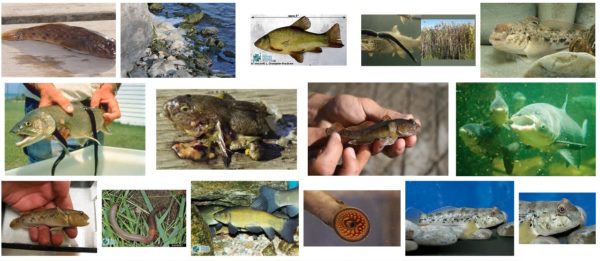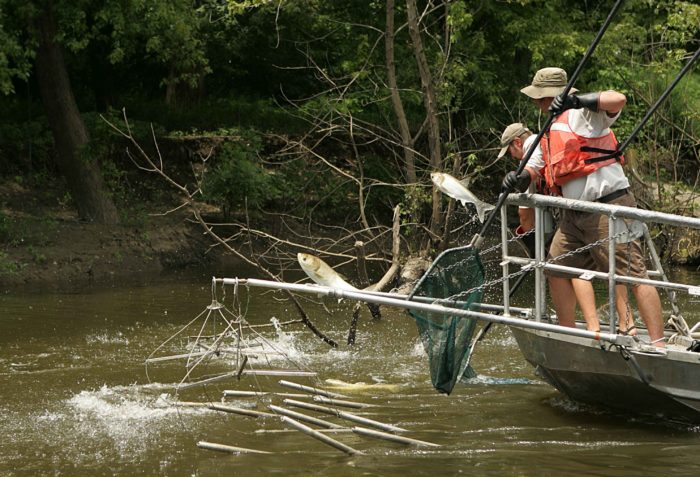No perch or pickerel in Lake Erie’s fisheries future? The tasty fish our Great Lakes are known for, and all other sport fish, could be decimated if the insidious Asian carp migrate from the Mississippi watershed.
Combined, the four Asian carp species could decimate the Great Lakes fishery by out competing our native fish.
Plankton, which is the base of the Great Lakes food chain, is consumed by silver and bighead carp. Grass carp prefer plants while black carp eat mollusks. Asian carp can consume up to 20 per cent of their weight every day.
Since escaping impounds near the mouth of the Mississippi River, the carp have spread north and are very near the Great Lakes in the Chicago Sanitary and Ship Canal. So far, everything from electric barriers to water-propulsion jets to noise cannons have been considered to keep them at bay.

But, the systems aren’t perfect. A silver carp was caught on June 22, just nine miles from Lake Michigan. Two weeks of intensive monitoring did not find any other carp. The captured fish has been sent for laboratory analysis to search for more clues on how it got there.
While some fear this is the beginning of the end, it should be noted that a bighead carp was also found in the area in 2010. The protocol for stepped-up monitoring wasn’t in place then, but no Asian carp have been found in the area in the ensuing seven years.
Most of the media attention rightfully is focused on the Chicago Sanitary and Ship Canal (zoom and scroll on the map above) as a route for the invasion, but it is not the only possible route. Silver carp have been found in the Ohio River and that state’s Little and Great Miami Rivers – all pathways to Lake Erie. Barriers have improved in Indiana’s Eagle Marsh, where, during flooding, there is a possibility carp could move from the Mississippi watershed to Lake Erie.
Although science and technology continue the search for solutions to the Asian carp threat, politics can get in the way. The Great Lakes states, with the exception of Illinois and Indiana, were in favor of blocking the Chicago Sanitary and Ship Canal. Perhaps the last president hailing from Chicago was a factor in this not happening.
While on holidays in Louisiana, I testified at Army Corps of Engineers hearings for their Great Lakes and Mississippi River Interbasin Study. I support chemical, electrical, vibration and other methods used to deter invasives moving up the Chicago canal.
The U.S. administration has stalled the release of their report, although two weeks ago, the U.S. Senate Appropriations Committee approved a bill that would force its release. The bill had support from both sides of the House.
Similarly, there has been bi-partisan support to block a move in the presidential budget that would slash the Great Lakes Restoration Initiative funding from $300 million to zero. A portion of that funding goes to Asian carp programs.
On the home front, I have pushed for legislation that Asian carp brought into Ontario for food must first be eviscerated.
Ontario has passed the Invasive Species Act, becoming the first province with legislation dedicated to addressing the threat. Asian carp are included in this law.
Much of the attention and expenditure on Asian carp has been south of the border. In my view, more could be done in Ontario. For the Silo, MPP Toby Barrett.
Featured image- Electrofishing for the invasive Asian carp (Photo By U.S. Fish and Wildlife Service [Public domain]
Supplemental- Is Asian Carp ‘invasion’ actually a secret ‘stocking initiative’ for bolstering commercial fishing? Published on 13 Aug 2013 Asian Carp Processing Plant- Kentucky -Two Rivers Fisheries in Wickliffe, KY is taking a run at the Asian Carp market. With an abundance of Bighead and Silver carp in nearby waterways, the fish market is set to process and sell these fish for consumption. Commercial fishermen have often said if you pay us for the invasive carp we will catch them and that is exactly what is happening in Western Kentucky.


Leave a Reply
You must be logged in to post a comment.